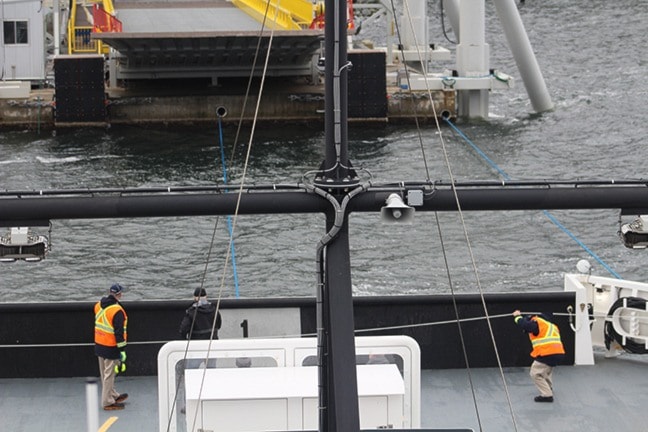In a 20-day period in February, the self-propelled MV Quinitsa ferry, serving the Buckley Bay-Denman Island route, made 16 sailings in relief of the newly-implemented Baynes Sound Connector cable ferry.
According to BC Ferries, from Feb. 9 to 29, the cable ferry made 566 sailings, meaning the Quinitsa was called upon in relief once every 35 sailings. But BC Ferries will remove the Quinitsa from standby service at the end of the month.
“We’re taking a cautious approach,” says Capt. Jamie Marshall, vice-president of operations for BC Ferries. “There are the usual teething pains with any new vessel that goes into service.”
Despite working through maintenance issues, Marshall notes the Baynes Sound Connector is “doing very well” and residents are not experiencing interruptions in service.
The $15-million, 78.5 metre cable ferry began service late January with ‘soft sailings’ and regular sailings in February. It is capable of carrying 50 vehicles and 150 passengers, and with a crossing of about 1,900 metres, it is believed to be the longest cable ferry in the world.
The Baynes Sound Connector faced opposition in recent years from residents of Denman and Hornby islands, concerned about safety and reliability.
The ferry has met the corporation’s expectations, says Marshall, with a 55 per cent reduction in fuel costs and a potential of around $70 million worth of savings over the life of the vessel. He adds residents’ concerns about the project have been met.
“(In high winds or storms) it has exceeded our expectations. The cables act as a dampening effect (for stability).”
Additionally, he says, the corporation enacted its protocol with the Department of Fisheries and Oceans during the herring run, and explains while the ferry was held for a few minutes on certain sailings, there was good communication with commercial vessels in the area.
Ambulance runs, most recently performed on March 8, was “exactly the same as the Quinitsa,” adding because of a smaller crew (from six to four), there is the possibility of getting them onto the ferry and leaving Denman Island more quickly.
Despite this, some Island residents continue to raise concerns over its dependability, particularly once the Quinitsa leaves from service.
“When it leaves, we are concerned that we’ll be stranded … many people liked the Quinitsa and even when it got windy, it almost never got cancelled. It’s the perfect boat for the size of the run,” notes Denman resident Rae Eckel.
“There’s lots of commuters or people who have meetings or hospital visits. If there’s no ferry (if it breaks down), what are they going to do if there’s no back-up?
Meanwhile, 12-year Denman resident Rob Wiltshire says not all considerations for the new ferry are being looked at, particularly from a cost-saving and environmental standpoint.
Wiltshire notes the vessel uses one engine instead of four, which translates into far less CO2 emissions while carrying the same number of cars and maintaining similar crossing times.
It will save BC Ferries money, he adds, which will help to reduce further fare increases.
• • •
On the Quinitsa - like on all self-propelled vessels in their fleet - Marshall says there are licensed engineers on board. On the Baynes Sound Connector, there is a lead operator, a second operator and two deckhands.
Any maintenance on the cable ferry is done by skilled trades personnel from the Little River (Comox) maintenance depot who come on board the vessel while on run or at the evening during graveyard and perform the necessary maintenance.
Marshall notes there could be a delay in sailing if a repair is needed on the vessel with outside personnel required.
Depending on the issue, outside contractors have been called in from Vancouver and Nanaimo to assist, he explains, and adds the vessel is under a one-year warranty from Seaspan’s Vancouver shipyards.
The Baynes Sound Connector is set to be taken out of service in the fall to “address any warranty issues,” and the Quinitsa will be the replacement vessel during that time.
Graeme Johnston, provincial president of the BC Ferry & Marine Workers’ Union, says if an employer wants to bring in new technology, there will inevitably be changes, but credits BC Ferries for their severance packages for employees no longer working on the new ferry.
Rather, the concern for the union is safety.
“The previous crew had six (people), and now there’s four. At the maximum, there’s 150 people with four crew members, and none who are certificated ship officers. That’s troubling to us.”
He says it’s the position of the union that the ferry should be crewed with a minimum of five people, one of which should be a certified crew master.
“It is a cable ferry navigating through an active channel; there’s still a lot of different elements that go into navigating. The union would prefer to see someone with an engine room rating (certificate) if something goes wrong mid-channel … it’s still a motorized vessel. What happens if the vessel stops? There’s nobody on the boat who is able to perform repairs in their job descriptions.”
• • •
At the end of March once the Quinitsa is gone, Eckel says many residents will find dependability on the system “daunting.”
“New things don’t always run smoothly but there have been a lot of funny little things happening,” she concedes.
“We’re Islanders and we love it here, and if there’s no ferry, you can’t go until you can go. We’re stuck with it, and we have to make the best of it, but if (the Connector breaks down) what the heck are we going to do?”
